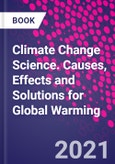Climate Change Science: Causes, Effects and Solutions for Global Warming presents unbiased, state-of-the-art, scientific knowledge on climate change and engineering solutions for mitigation. The book expands on all major prospective solutions for tackling climate change in a complete manner. It comprehensively explains the variety of climate solutions currently available, including the remaining challenges associated with each. Effective, complementary solutions for engineering to combat climate change are discussed and elaborated on. Some of the more high-risk proposals are qualitatively and quantitatively compared and contrasted with low-risk mitigation actions to facilitate the formulation of feasible, environmentally-friendly solutions.
The book provides academics, postgraduate students and other readers in the fields of environmental science, climate change, atmospheric sciences and engineering with the information they need for their roles. Through exploring the fundamental information currently available, exergy utilization, large-scale solutions, and current solutions in place, the book is an invaluable look into how climate change can be addressed from an engineering-perspective using scientific models and calculations.
Please Note: This is an On Demand product, delivery may take up to 11 working days after payment has been received.
Table of Contents
1. Engineering for climate change2. Pros and cons of climate change
3. Man-made versus natural causes
4. Population, urbanization and climate change
5. Alternate view, dynamics of self-adjusting earth
6. The climate change equation, y = f(x1, x2, x3, .)
7. When will exergy be exhausted?
8. The second law of thermodynamics and climate change
9. What is the threshold for doomsday?
10. Is carbon dioxide an accurate measure?
11. Large-scale solutions
12. Low-risk mitigations
13. Deep sea and climate change








